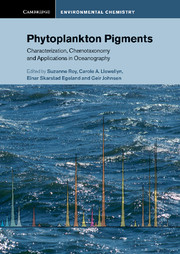Book contents
- Frontmatter
- Contents
- Contributors
- Preface
- Acknowledgements
- Abbreviations and symbols
- Part I Chlorophylls and carotenoids
- Part II Methodology guidance
- Part III Water-soluble ‘pigments’
- Part IV Selected pigment applications in oceanography
- Part V Future perspectives
- Part VI Aids for practical laboratory work
- Part VII Data sheets aiding identification of phytoplankton carotenoids and chlorophylls
- Index
- Plate Section
Part VII - Data sheets aiding identification of phytoplankton carotenoids and chlorophylls
Published online by Cambridge University Press: 05 March 2012
- Frontmatter
- Contents
- Contributors
- Preface
- Acknowledgements
- Abbreviations and symbols
- Part I Chlorophylls and carotenoids
- Part II Methodology guidance
- Part III Water-soluble ‘pigments’
- Part IV Selected pigment applications in oceanography
- Part V Future perspectives
- Part VI Aids for practical laboratory work
- Part VII Data sheets aiding identification of phytoplankton carotenoids and chlorophylls
- Index
- Plate Section
Summary
Introduction
Since the publication of 47 key phytoplankton pigment data sheets in the volume by Jeffrey et al. (1997b), several new algal groups and pigments have been reported. To reflect this and the increased use of mass spectrometry for phytoplankton pigment characterisation we have compiled revised and expanded data sheets documenting 47 carotenoids and 21 chlorophylls. These new data sheets complement the ones produced for the 1997 volume. They are also available online, at www.cambridge.org/phytoplankton, for ease of consultation. We do not include data sheets for the many chlorophyll transformation products found particularly in sediments; for information on these pigments readers should refer to the comprehensive review by Keely (2006). Similarly, our coverage of pigments contained in phototrophic bacteria is limited mostly to cyanobacteria found in the water column of freshwater and marine environments (see Chapter 1, this volume), hence we exclude the newly discovered chlorophyll f in stromatolites (Chen et al., 2010). Readers interested in anoxygenic phototrophic bacteria should consult the reviews by Takaichi (1999) and Scheer (2006).
- Type
- Chapter
- Information
- Phytoplankton PigmentsCharacterization, Chemotaxonomy and Applications in Oceanography, pp. 665 - 674Publisher: Cambridge University PressPrint publication year: 2011



